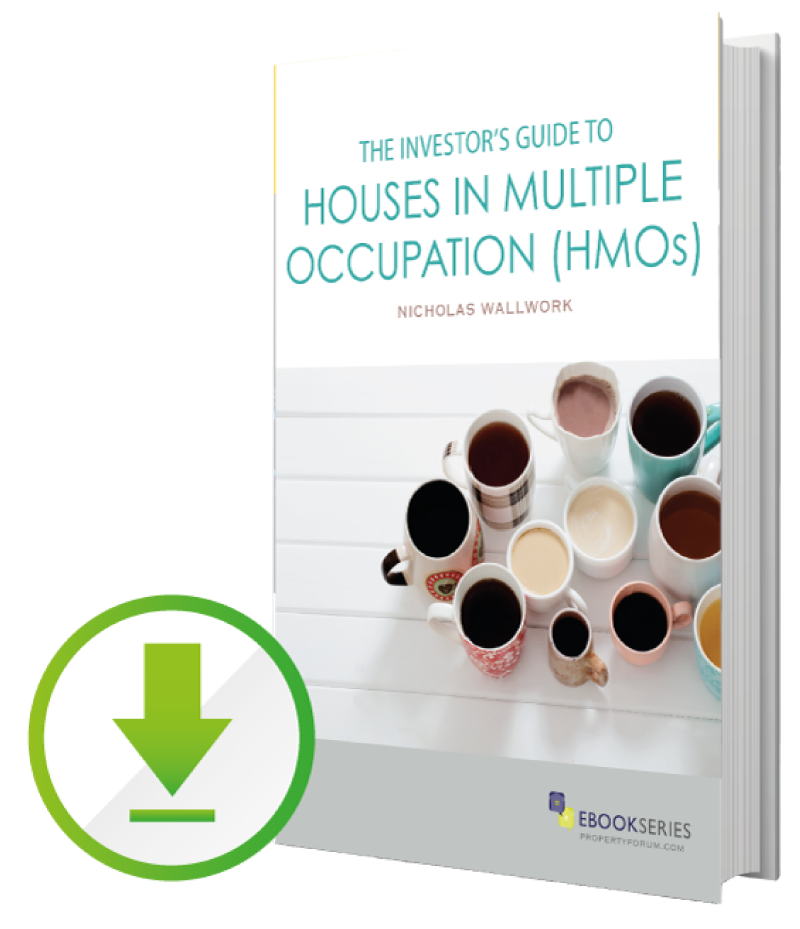Houses in Multiple Occupation (HMOs)
If you would like to learn how to build a successful HMO portfolio, you are in the right place. Download our free ‘Guide to Investing in HMOs’ to get started, then use the wealth of resources on this page to learn more, including videos, HMO news articles, HMO mentorships and much more.
HMO ebook download

Chat in our HMO forum for free!
HMO is a term that is used to define accommodation that is owned by a private landlord and shared among a number of people. The acronym stands for a House in Multiple Occupation. There are a range of different types of accommodation that could fall under this definition, depending on how many people are living there and what the living arrangements are. Use the resources on this page or ask a question in our dedicated HMO chat forum to learn more.
Not all shared property can be classified as an HMO. For a rental property to come under this category, the UK Government has stated that a property must have three to six tenants residing there. These tenants, from more than one household, need to have a shared kitchen or shared bathroom facilities.
A household is defined as either a single individual or members of the same family who live together. A family includes a married couple or a couple who are living together (including same-sex relationships); relatives or half-relatives, such as grandparents, siblings, aunts and uncles; step-parents and step-children.
For example, if you live in a three-bedroom house and choose to rent out the remaining two bedrooms, the property would not qualify as an HMO. The arrangement would fall short of the requirements as there would only be two tenants. But, if you converted the living room into an additional bedroom and rented it out, the house would now class as an HMO.
HMOs, however, are not restricted to houses. It is possible for a shared flat to also come under this category, along with a house split into separate bedsits, a hostel, a bed-and-breakfast hotel that is not solely targeted for tourists, and some shared accommodation for students.
To summarise, in England an HMO is any building which meets with one of the three tests:
The ‘Standard Test’
If a house or flat has at least three tenants, from more than one household, sharing one or more basic amenities (toilet, bathroom, or kitchen), it is considered an HMO.
The ‘Self-Contained Flat Test’
A self-contained flat, which meets the same occupant and/or amenity criteria.
The ‘Converted Building Test’
A building that has been converted into self-contained flats and is not entirely comprised of self-contained units can also qualify. For a converted block of flats, if they were redeveloped without complying to the 1991 Building Regulations, then they would be categorised as an HMO. For example, where fewer than two-thirds of the flats are owner-occupied, these buildings would come under a ‘Section 257 HMO.’
‘Large’ HMOs
Another category of houses of multiple occupancies is ‘large’ HMOs, sometimes referred to as a ‘house share.’ A property will be defined with this term if it applies to the following:
- Five or more people, from more than one household, all renting a room in the same property.
- Some or all of the tenants sharing a toilet, bathroom or kitchen amenities.
- At least one tenant pays rent (or an employer pays it on their behalf).
The rules surrounding ‘large’ HMOs change frequently, and it is always advised to keep up to date with the regulations. However, currently, it is required mandatory to have a licence if you’re renting out an HMO in England and Wales.
These licences are valid for a maximum of five years, and landlords are required to have a separate permission for each HMO they may have. Upon issue or renewal of a licence, the council will check to see that the HMO meets an acceptable standard; ensuring the property can comfortably accommodate the number of occupants it is proposing. The council will also vet the landlord.
In some local councils, licences are also required to rent out a smaller HMO. Before going ahead with your HMO property investment, it is crucial you visit the relevant local council’s website. You can be fined for renting out rooms of an unlicensed HMO.
There are a few instances when HMOs are exempt from this license. If the HMO is owned by a housing association, a council, a health service, or a police or fire authority, then no licence is needed.
Before investing your money into an HMO property development, it is important to decide upon the target tenants for your rooms. This choice will significantly affect the decisions you make at each step of your investment.
HMO properties are appealing housing options for three groups of tenant profiles:
- Students (most only require a room for the academic year)
- Young professionals (young people who are waiting to get onto the property ladder)
- Social housing and DSS (Decision Support System) tenants (typically local council or housing association tenants, but most investors would ordinarily lease their HMO to the organisation rather than individual tenants)
How to choose which one you should target?
Each profile of tenant comes with their respective advantages and disadvantages for an investor. As a first-time investor, this decision can come down quite simply to what group of people you want to deal with (or live with, in some situations). However, there is also a financial bearing.
The majority of investors favour professional tenants, solely because they are perceived as being more reliable tenants and more likely to pay each month’s rent. But, this tenant market is known for being fussier regarding the quality of their accommodation; wanting higher-spec kitchens and bathrooms, as well as high-speed internet connections. For an investor, this could result in more renovation work before you are in a position to let out the rooms; as well as more ongoing maintenance costs.
Students, on the other hand, tend to be less fussy regarding amenities; however, they do get a reputation for causing more wear and tear. There can also be a higher tenant turn around as students typically move on every year.
Social housing and DSS tenants tend to be the least popular choice for HMO investors. But, renting your HMO to a social housing provider can prove a savvy decision. These organisations are more likely to rent the property for a five year period, covering all the utility bills, vacant periods and rent arrears within this time.
By taking your time planning out the layout of your HMO, adding a couple of extra bedrooms and redesigning the communal living space, you can maximise the profit potential of your property investment.
We are not encouraging you to cram in as many bedrooms as possible. To be guaranteed your HMO licence, your bedrooms must comply with the size regulations:
- 51 square metres for a person aged ten or over.
- 22 square metres for two people aged ten or over.
- 64 square metres for a child under ten years old.
Some councils choose to set their own standards on bedroom sizes, so you must check with the local council in your property’s area.
However, by restructuring the internal layout of your HMO, you can offer your tenants a comfortable living environment, while maximising your investment’s potential. Additionally, if you take the time rethinking the plans, you will make your HMO more desirable for tenants too.
As a landlord of an HMO, there are extra responsibilities you will need to take on in compliance with the Management of Houses in Multiple Occupation (England) Regulations 2006. These regulations impose various standards on anyone managing an HMO to help control health and safety risks, and ensuring the accommodation is fit for tenants. These requirements include:
- The proper fire safety measures are in place; this includes working smoke alarms.
- Annual gas safety checks.
- The electrics are checked every five years without fail.
- The property is not overcrowded.
- Your property offers enough cooking and bathroom facilities for the number of tenants.
- All communal areas and shared facilities are clean and in good repair.
- There are enough waste disposal facilities.
If you are convicted of breaching these regulations, you could face a fine of up to £5,000 per offence.
Repairs to any communal areas in your HMO will include:
- The property’s exterior and structure, including the repair work to walls, window frames and gutters.
- Water and gas pipes.
- All electrical wiring.
- The general repair and maintenance of shared facilities, such as basins, sinks, baths and toilets.
- Radiators and water heaters.
For an extensive list of HMO licensing regulations, download our HMOs ebook from the top of this page.
To turn a property into an HMO, most investors need to secure funding. Usually, this is done through a specialist HMO mortgage.
HMO Mortgages
Finding a mortgage for an HMO property can be more challenging than a standard mortgage agreement, and consequently, these mortgages are subject to higher fees and interest rates. The ‘larger’ your HMO, the more costs that are involved in finding a mortgage provider. In some cases, you may need to consider a commercial mortgage for a ‘large’ HMO.
Mortgage lenders will firstly assess the ‘exit strategy’ of any potential borrowers. For HMO properties, this strategy is considered on the potential rental income for the property if it was let out as a family unit.
When considering a specialist mortgage option, it is recommended to speak to an intermediary or master broker. At Property Forum we have teamed up with a highly recommended and specialist, UK finance broker. If you would like more advice about HMO mortgages, you can book a call with our recommended broker.
HMOs are a reasonably low-risk investment option and offer a much higher yield than standard Buy-to-Let investment property. This may come as a surprise since there is a lot of tenants to manage and complexities surrounding licensing and regulations. But, unlike buy-to-let properties, with an HMO even if one room is vacant, other rooms can be earning money. With multiple tenants, numerous rental agreements are covering the bills and your mortgage repayments. Many HMO property investors can double their rental income, simply because they have more rooms to rent out.
Yes, HMOs require more time and effort in the managing of tenants and maintenance of the property; however, as you scale up your HMO portfolio, you may be able to outsource this work to a managing agent. If you would like more information on HMO property investments, download our free ebook today, join in the conversation on our HMO chat forum, or book a free 1-2-1 mentorship session with HMO expert Nicholas Wallwork.
Watch almost 2 hours of invaluable HMO tips and advice...
We recently broadcast a special HMO Chat Show with the infamous “HMO Daddy” (of TV fame). Also known as Jim Haliburton, this HMO episode shared vital expertise for anyone considering starting or expanding an HMO property portfolio.
Watch the episode now using the link below.
Read the latest news articles on HMOs...
Have you considered an HMO mentorship with an expert?
Nicholas Wallwork (Property Forum’s CEO) has built the majority of his £30million+ property portfolio using the HMO investment strategy. If you want to fast track your success in HMO property developing, you can take advantage of his expertise with 1-2-1 mentorship sessions with Nicholas, as he helps you maximise the profit potential of your next HMO and shows you how to scale a successful HMO portfolio.
Learn more about other property investment strategies...

Holiday Lets, Air BNB and buying overseas
Learn more about owning your own Holiday Let property investment (whether it’s in the UK or overseas), including how to source, manage, finance and advertise a successful holiday let.

Lease options and rent to rent investments
Lease Options and Rent-to-Rent property investment provide an opportunity to get into property investing with little up front capital. Find out more with our free ebook downloads.

Property development, auctions and land
Property developing can come in many forms, including renovation projects, change of use conversions, and land development. This page explains all your options with property development.

